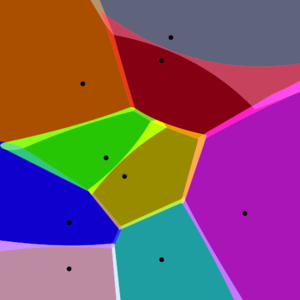Voronoi diagram (nonfiction): Difference between revisions
Jump to navigation
Jump to search
No edit summary |
No edit summary |
||
| Line 33: | Line 33: | ||
* [https://www.voronator.com/ Voronator] - upload 3D model, download your voroni tesselated version | * [https://www.voronator.com/ Voronator] - upload 3D model, download your voroni tesselated version | ||
* [http://karljones.com/voronoi/ Voronoi experiment] @ karljones.com | * [http://karljones.com/voronoi/ Voronoi experiment] @ karljones.com | ||
* [https://www.desmos.com/calculator/ejatebvup4 Fortune's algorithm for Voronoi diagrams] | |||
* [https://www.cs.columbia.edu/~pblaer/projects/path_planner/ Robot Path Planning Using Generalized Voronoi Diagrams] | * [https://www.cs.columbia.edu/~pblaer/projects/path_planner/ Robot Path Planning Using Generalized Voronoi Diagrams] | ||
Revision as of 12:37, 30 September 2018
In mathematics, a Voronoi diagram is a partitioning of a plane into regions based on distance to points in a specific subset of the plane.
It is named after Georgy Voronoi, and is also called a Voronoi tessellation, a Voronoi decomposition, a Voronoi partition, or a Dirichlet tessellation (after Peter Gustav Lejeune Dirichlet).
Voronoi diagrams have practical and theoretical applications to a large number of fields, mainly in science and technology but also including visual art.
In the News
Fantasy Voronoi diagram color commentators discussing recent scores from hotly contested Voronoi diagrams.
Fiction cross-reference
Nonfiction cross-reference
External links:
- Voronoi diagram @ Wikipedia
- Jump Flood Voronoi for WebGL
- Voronoi Tessellation
- Voronoi Tesselation - Paper.js
- Voronator - upload 3D model, download your voroni tesselated version
- Voronoi experiment @ karljones.com
- Fortune's algorithm for Voronoi diagrams

